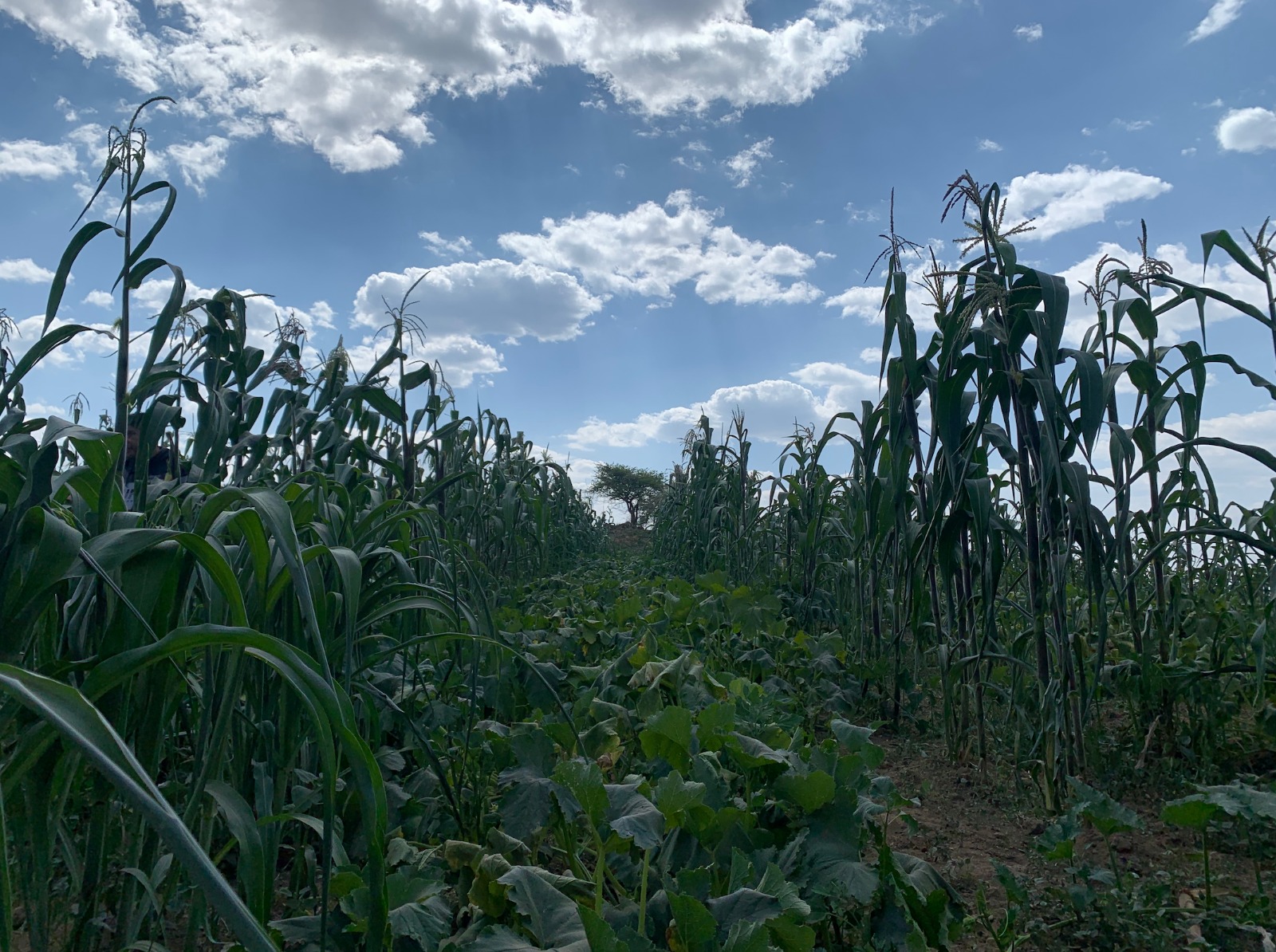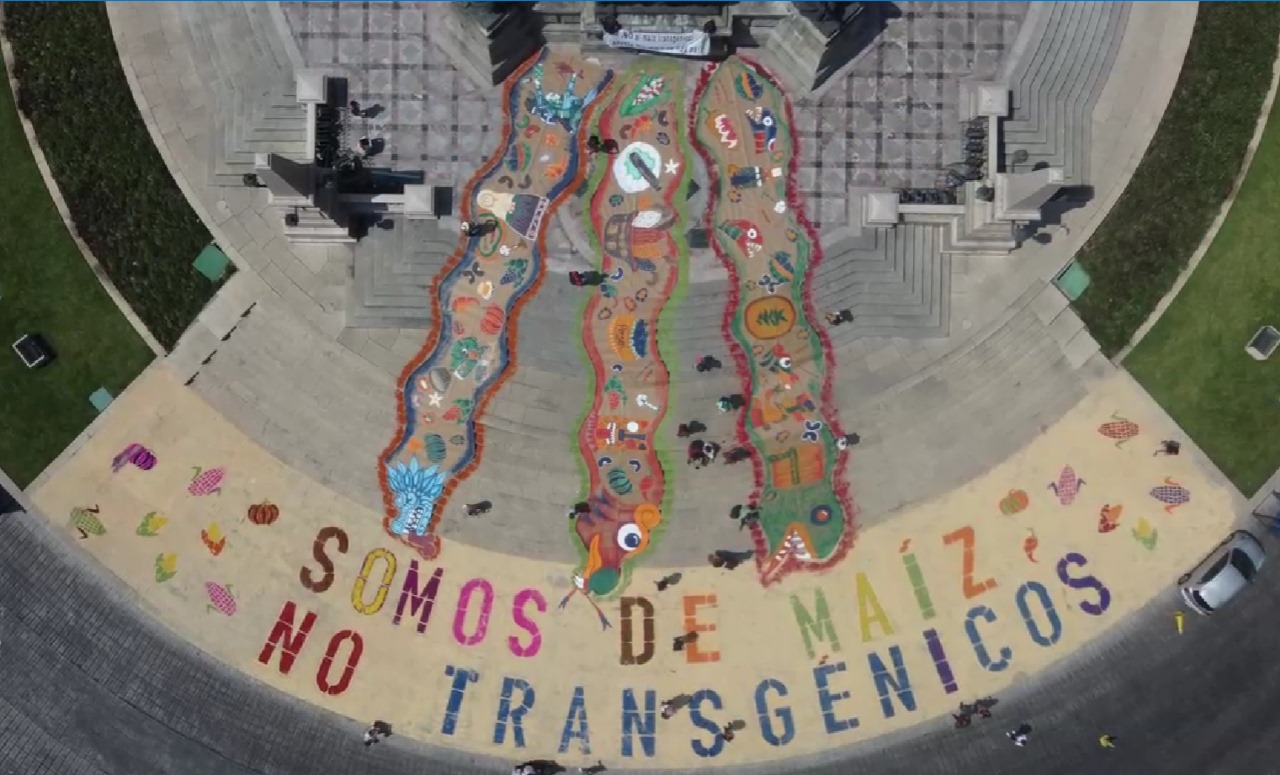In Mesoamerica, we have a myth that explains how corn was created and why it exists in so many different colors. Coatepetl, a hill that contained the different varieties of native corn and, was struck by the god of lightning, Tlaloc, and all the corn flew off into our world. The seeds that were closer to the surface, were burned, resulting in blue, indigo and black seeds, while the kernels that were deeper down were not affected–they are the white and yellow kernels.
Mexico and Central America are the center of origin for corn and where most diversity still exists. Corn was domesticated In what is now Mexican territory, and thanks to the practices of selection, conservation and exchange of seeds over millennia, today there is an extensive variety of creole corn (59 landraces in Mexico alone, according to the National Council on Biodiversity).

These practices have been led by women. In Mesoamerican societies, corn is usually planted in the milpa, an ancient polyculture system that, depending on the region, is planted with different elements. The three basic ones are corn, squash and beans.
A class-action lawsuit to protect native corn
On July 5, 2013, a group of 52 people and 22 Mexican civil society organizations filed a suit to prohibit the cultivation of genetically modified corn in Mexican territory, due to the risk it poses to environment, health and biodiversity, in addition to the economic, social and cultural risk. The group won a suspension under a precautionary measure that prevented planting genetically modified corn.
This movement has achieved a huge victory over transnational behemoths like Bayer-Monsanto by blocking the cultivation of genetically modified corn throughout the country after gaining a favorable ruling from the National Supreme Court of Justice in 2021 and winning an appeal promoted by the collective of scientists, peasants, activists and lawyers. The trial is still ongoing.
The agribusiness transnationals that manufacture genetically modified seed have carried out a constant legal and PR offensive to defeat the collective effort. Bayer-Monsanto is the best known, but there are others as well that are trying to impose their agrifood system on us, based on the monoculture of genetically modified seeds that require agrotoxins to survive. They are trying to impose the massive cultivation of these genetically modified seeds on Mexican farmers and among Mexican consumers. The risks that this would imply have been documented and can be seen in different areas.
The class action lawsuit has served as an inspiring precedent for environmental and human rights movements.
First, there is the risk of losing our native corn varieties. Corn is open pollinated, which means that it travels on the wind, so our corn varieties would be contaminated with genetically modified seeds. Transgenic corn is created in laboratories to resist toxic agro-chemicals. The use of these agrochemicals means that the corn could no longer be planted in a polyculture–the herbicides kill the beans, squash and medicinal plants that are grown alongside corn in the milpa. The biodiversity of the milpa would be lost and everything would be a monoculture.
The second risk is to consumer health. Transgenic corn is created to resist herbicides, pesticides and fungicides. The use of these harmful substances in the production of food for human consumption is increasing. The best known of these pesticides is glyphosate, which has been classified by several organizations, including the international Food and Agriculture Organization (FAO), as potentially carcinogenic.
Then there is the cultural and social risk. Planting genetically modified corn means that millennial practices would be lost. Transgenic corn is not compatible with the milpa system of traditional agriculture in the region that, in addition to its ecological sustainability and food productivity, also builds and sustains the social fabric in peasant communities. Everyone contributes what they can according to their abilities in this system of collective work. An example of this is the Vicente Guerrero Group in Tlaxcala that grows corn, squash and beans, as well as fruit trees following the system of milpa mixed with fruit trees known as MIAF (Milpa Intercalada con Árboles Frutales).
Finally, the economic risk. Laboratory-created maize follows a capitalist logic that seeks mass production and sale. Patenting these seeds eliminates the ancestral practice of selecting and saving the best seeds from each place, thus sharing the advances and adapting to particular climatic conditions, culinary customs and ecosystems. The companies, on the contrary, seek to sell their patented seeds everywhere in order to privatize all the steps from planting to harvest and consumption. In this way, seed-saving and the free exchange of seeds would be completely lost.

Another disadvantage for Mexican small farmers is that GMO seeds only produce for one agricultural cycle, preventing the selection and safeguarding of seeds and forcing farmers to buy from the companies every year. The importance of the traditional seed-saving process is that through the ancestral knowledge and constant selection of producers, the seeds are improved in a natural and almost artisanal way so that they are the most suitable for the particular land and uses. With this imposition, the farmers would have to buy seeds for each cycle, generating an annual expense that few can afford and that they could save if they were allowed to continue with their methods.
Seeds are common goods. Seeds have been improved thanks to the work of peasant farmers who, generation after generation, select the seeds that are best adapted. Corn should be in seed banks and in peasant hands.
The class action lawsuit has served as an inspiring precedent for environmental and human rights movements. It has gained widespread international support. For example, in Colombia there is the Monsanto Law that proposes the eradication of glyphosate and movements against GMOs in Chile and Argentina continue to grow.
Despite the scientific arguments and social support for prohibition, on September 29 Judge Victor Miguel Bravo Melgoza issued a ruling against the collective: In clear deference to corporate agribusiness lawyers, he denied the protection of the biodiversity of native corn in Mexico. Despite the ruling and thanks to an injunction filed by the community and the Supreme Court ruling, the planting of genetically modified corn is still prohibited.

The National Day of Maize is celebrated every September 29th. This celebration also celebrates the biodiversity and culture represented by this grain and the milpa system. The day was adopted officially in Mexico years ago, following the initiative of civil society and peasant groups. This day of celebration became a day of indignation when the adverse ruling was announced on the very same day – September 29, 2023 – against the class action lawsuit that would ban planting genetically modified corn in our country.
Attempts to impose a food system governed by capitalism will continue. However, for more than two decades, when genetically modified products promoted by transnational corporations such as Monsanto entered the market, peasant organizations have been very clear that food and the way it is produced cannot be ruled by this logic. Since the early nineties, they demanded that corn not be included in the North American Free Trade Agreement due to its ecological, social, nutritional and economic importance. Farmer organizations movilized again to demand that it be removed from NAFTA a few years later. They lost this battle and, as they foresaw, the companies now seek to use the trade agreement to impose their model of agriculture that threatens health, the environment and culture by challenging the prohibition on genetically modified corn and glyphosate.
Seeds are common goods. Seeds have been improved thanks to the work of peasant farmers who, generation after generation, select the seeds that are best adapted. Corn should be in seed banks and in peasant hands.
The class action lawsuit against the planting of transgenic corn has received a reprieve from the negative sentence. This ruling does not ruin everything that has been built at the grassroots level and achieved in legal initiatives–the achievements go way beyond that.
In recognition of their work to conserve native corn and the peasant culture and economy, on October 23, 2023, the Collective Demand Against the Planting of Transgenic Corn received the Pax Natura award. Upon receiving this award, the group received congratulations from other movements for a just food system. A broad global movement was on display that has many fronts in Latin America -Colombia, Chile, Bolivia, Argentina and Brazil- that fight day by day against the big transnationals and also joins with movements in India, North America and Africa. It is a common struggle among the Global Majority against privatization, monocultures and agrotoxics.
It is a struggle for maize, for seeds, for life, and for the value of the collective and the community.
José Sampietro works at Mira: Feminisms and Democracies as a research assistant. He studied Political Science in the National Autonomous University in Mexico (UNAM) and his work is related to food systems.



